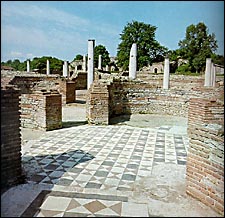 After this initial blooming of the Serbian state,
a period of stasis and retrogression followed.
Marked by disintegration and crises it lasted
until the end of 12th century. After a struggle
for the throne with his brothers, Stefan Nemanja, the
founder of the Nemanjic dynasty, rose to power in 1170
and started renewing the Serbian state in the Raska region.
Sometimes with the sponsorship of Byzantium, and sometimes
opposing it, the veliki zupan (a title equivalent
to the rank of prince) Stefan Nemanja expanded his state
seizing territories east and south, and newly annexed the
littoral and the Zeta region. Along with his governmental
efforts, the veliki zupan dedicated much care to
the construction of monasteries. His endowments include
the Djurdjevi Stupovi Monastery and the Studenica Monastery
in the Raska region, and the Hilandar Monastery on Mt. Athos.
After this initial blooming of the Serbian state,
a period of stasis and retrogression followed.
Marked by disintegration and crises it lasted
until the end of 12th century. After a struggle
for the throne with his brothers, Stefan Nemanja, the
founder of the Nemanjic dynasty, rose to power in 1170
and started renewing the Serbian state in the Raska region.
Sometimes with the sponsorship of Byzantium, and sometimes
opposing it, the veliki zupan (a title equivalent
to the rank of prince) Stefan Nemanja expanded his state
seizing territories east and south, and newly annexed the
littoral and the Zeta region. Along with his governmental
efforts, the veliki zupan dedicated much care to
the construction of monasteries. His endowments include
the Djurdjevi Stupovi Monastery and the Studenica Monastery
in the Raska region, and the Hilandar Monastery on Mt. Athos.
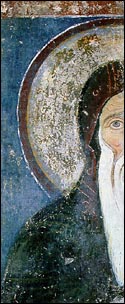
Stefan Nemanja was succeeded by his middle son Stefan,
whilst his first-born Vukan was given the rule of the Zeta
region (present-day Montenegro). Stefan Nemanja's youngest
son Rastko became a monk and took the name of Sava, turning
all his efforts to spreading religiousness among his people.
Since the Curia already had ambitions to spread its influence
to the Balkans as well, Stefan used these propitious
circumstances to obtain his crown from the Pope thus
becoming the first Serbian king in 1217. In Byzantium,
his brother Sava managed to secure the autocephalous status
for the Serbian Church and became the first Serbian archbishop
in 1219. Thus the Serbs acquired both forms of independence:
temporal and religious.
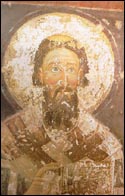 The next generation of Serbian rulers - the sons of Stefan
Prvovencani - Radoslav, Vladislav and Uros I, marked a period
of stagnation of the state structure. All three kings were more
or less dependent on some of the neighboring states - Byzantium,
Bulgaria or Hungary. The ties with the Hungarians had a decisive
role in the fact that Uros I was succeeded by his son Dragutin whose
wife was a Hungarian princess. Later on, when Dragutin abdicated in
favor of his younger brother Milutin, the Hungarian king Ladislaus IV
gave him lands in northeastern Bosnia, the regions of Srem and Macva,
and the city of Belgrade, whilst he managed to conquer and annex lands
in northeastern Serbia. Thus, all these territories became part of
the Serbian state for the first time.
The next generation of Serbian rulers - the sons of Stefan
Prvovencani - Radoslav, Vladislav and Uros I, marked a period
of stagnation of the state structure. All three kings were more
or less dependent on some of the neighboring states - Byzantium,
Bulgaria or Hungary. The ties with the Hungarians had a decisive
role in the fact that Uros I was succeeded by his son Dragutin whose
wife was a Hungarian princess. Later on, when Dragutin abdicated in
favor of his younger brother Milutin, the Hungarian king Ladislaus IV
gave him lands in northeastern Bosnia, the regions of Srem and Macva,
and the city of Belgrade, whilst he managed to conquer and annex lands
in northeastern Serbia. Thus, all these territories became part of
the Serbian state for the first time.
 Under the rule of Dragutin's younger brother - King Milutin, Serbia
grew stronger in spite of the fact that occasionally it had to fight
wars on three different fronts. King Milutin was an apt diplomat
much inclined to the use of a customary medieval diplomatic expedients
- dynastic marriages. He was married five times, with Hungarian,
Bulgarian and Byzantine princesses. He is also famous for building
churches, some of which are the brightest examples of Medieval Serbian
architecture: the Gracanica Monastery in Kosovo, the Cathedral in
Hilandar Monastery on Mt. Athos, the St. Archangel Church in Jerusalem
etc. Because of his endowments, King Milutin has been proclaimed
a saint, in spite of his tumultuous life. He was succeeded on the
throne by his son Stefan, later dubbed Stefan Decanski. Spreading
the kingdom to the east by winning the town of Nis and the surrounding
counties, and to the south by acquiring territories on Macedonia,
Stefan Decanski was worthy of his father and built the Visoki
Decani Monastery in Metohija - the most monumental example of
Serbian Medieval architecture - that earned him his byname.
Under the rule of Dragutin's younger brother - King Milutin, Serbia
grew stronger in spite of the fact that occasionally it had to fight
wars on three different fronts. King Milutin was an apt diplomat
much inclined to the use of a customary medieval diplomatic expedients
- dynastic marriages. He was married five times, with Hungarian,
Bulgarian and Byzantine princesses. He is also famous for building
churches, some of which are the brightest examples of Medieval Serbian
architecture: the Gracanica Monastery in Kosovo, the Cathedral in
Hilandar Monastery on Mt. Athos, the St. Archangel Church in Jerusalem
etc. Because of his endowments, King Milutin has been proclaimed
a saint, in spite of his tumultuous life. He was succeeded on the
throne by his son Stefan, later dubbed Stefan Decanski. Spreading
the kingdom to the east by winning the town of Nis and the surrounding
counties, and to the south by acquiring territories on Macedonia,
Stefan Decanski was worthy of his father and built the Visoki
Decani Monastery in Metohija - the most monumental example of
Serbian Medieval architecture - that earned him his byname.
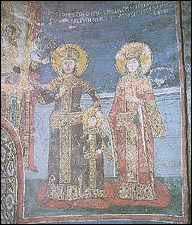 Medieval Serbia that enjoyed a high political, economic and cultural reputation in
Medieval Europe, reached its apex in mid-14th century, during the rule of Tzar
Stefan Dusan. This is the period when the Dusanov Zakonik (Dushan's Code) the
greatest juridical achievement of Medieval Serbia, unique among the European
feudal states of the period. St. Sava's Nomocanon, Dushan's Code, frescoes and
the architecture of the medieval monasteries adorning Serbian lands are eternal
civilizational monuments of the Serbian people. Tzar Stefan Dusan doubled the
size of his kingdom seizing territories to the south, southeast and east at the
expense of Byzantium. He was succeeded by his son Uros called the Weak, a term
that might also apply to the state of the kingdom slowly sliding into feudal
anarchy. This is a period marked by the rise of a new threat: the Ottoman Turk
sultanate gradually spreading from Asia to Europe and conquering Byzantium first,
and then the other Balkan states.
Medieval Serbia that enjoyed a high political, economic and cultural reputation in
Medieval Europe, reached its apex in mid-14th century, during the rule of Tzar
Stefan Dusan. This is the period when the Dusanov Zakonik (Dushan's Code) the
greatest juridical achievement of Medieval Serbia, unique among the European
feudal states of the period. St. Sava's Nomocanon, Dushan's Code, frescoes and
the architecture of the medieval monasteries adorning Serbian lands are eternal
civilizational monuments of the Serbian people. Tzar Stefan Dusan doubled the
size of his kingdom seizing territories to the south, southeast and east at the
expense of Byzantium. He was succeeded by his son Uros called the Weak, a term
that might also apply to the state of the kingdom slowly sliding into feudal
anarchy. This is a period marked by the rise of a new threat: the Ottoman Turk
sultanate gradually spreading from Asia to Europe and conquering Byzantium first,
and then the other Balkan states.

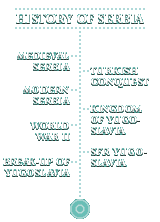



 After this initial blooming of the Serbian state,
a period of stasis and retrogression followed.
Marked by disintegration and crises it lasted
until the end of 12th century. After a struggle
for the throne with his brothers, Stefan Nemanja, the
founder of the Nemanjic dynasty, rose to power in 1170
and started renewing the Serbian state in the Raska region.
Sometimes with the sponsorship of Byzantium, and sometimes
opposing it, the veliki zupan (a title equivalent
to the rank of prince) Stefan Nemanja expanded his state
seizing territories east and south, and newly annexed the
littoral and the Zeta region. Along with his governmental
efforts, the veliki zupan dedicated much care to
the construction of monasteries. His endowments include
the Djurdjevi Stupovi Monastery and the Studenica Monastery
in the Raska region, and the Hilandar Monastery on Mt. Athos.
After this initial blooming of the Serbian state,
a period of stasis and retrogression followed.
Marked by disintegration and crises it lasted
until the end of 12th century. After a struggle
for the throne with his brothers, Stefan Nemanja, the
founder of the Nemanjic dynasty, rose to power in 1170
and started renewing the Serbian state in the Raska region.
Sometimes with the sponsorship of Byzantium, and sometimes
opposing it, the veliki zupan (a title equivalent
to the rank of prince) Stefan Nemanja expanded his state
seizing territories east and south, and newly annexed the
littoral and the Zeta region. Along with his governmental
efforts, the veliki zupan dedicated much care to
the construction of monasteries. His endowments include
the Djurdjevi Stupovi Monastery and the Studenica Monastery
in the Raska region, and the Hilandar Monastery on Mt. Athos.


